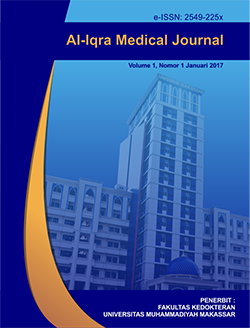POTENSI KOMBINASI AMIDO-BRIDGED NUCLEIC ACID MODIFIED ANTISENSE OLIGONUCLEOTIDES DENGAN POLYAMIDOAMINE DENDRIMER GENERASI 4 TERTARGET Α-SYNUCLEIN SEBAGAI TERAPI PARKINSON
DOI:
https://doi.org/10.26618/aimj.v4i1.4985Keywords:
AmNA-ASO, PAMAM Dendrimer, ParkinsonAbstract
Parkinson adalah penyakit neurodegeneratif yang meningkat lebih cepat daripada gangguan neurologis lainnya. Saat ini pengobatan Parkinson menggunakan dopamine agonist dan levodopa, namun pengobatan ini memiliki efek samping seperti menurunkan nafsu makan dan tidak berfokus pada pencegahan kematian neuron. Salah satu protein yang berperan dalam patogenesis dari Parkinson adalah protein α-synuclein, di mana agregasi dan misfolding dari protein ini bersifat toksik pada neuron sehingga mendukung progresi Parkinson. Antisense oligonucleotide (ASO) yang dikombinasikan dengan amido-bridge nucleic acid (AmNA) diketahui memiliki efek untuk menekan ekspresi mRNA α-synuclein namun hanya sebagian kecil dosis yang terdistribusi ke jaringan target sehingga diperlukan karier yang stabil. Polyamidoamine (PAMAM) Dendrimer menjadi pilihan dengan kemampuan menembus Blood Brain Barrier dan menarget organ secara spesifik. Secara khusus, PAMAM Dendrimer Generasi 4 (PAMAM G4) dapat menghambat agregasi protein α-synuclein. Oleh karena itu, mengombinasikan potensi yang dimiliki oleh AmNA-ASO dengan PAMAM Dendrimer Generasi 4 menggunakan larutan HEPES buffer diharapkan mampu menjadi terapi Parkinson yang menjanjikan.
References
Twelves D, Perkins KS, Counsell C. Systematic review of incidence studies of Parkinson’s disease. Mov Disord. 2010;18:19–31.
National Institute for Health and
Care Excellence (NICE) Parkinson’s disease: diagnosis and management in primary and secondary care. NICE clinical guidelines 35. Jun, 2016.
Dorsey ER, Constantinescu R, Thompson JP, et al. Projected number of people with Parkinson disease in the most populous nations, 2005 through 2030. Neurology 2010;68:384–6.
de Lau LML, Breteler MMB. Epidemiology of Parkinson’s disease. Lancet Neurol 2016;5:525–35.
Scope (prevalence and incidence) of neurological conditions. In: Mapping connections: an understanding of neurological conditions in Canada. Ottawa: Public Health Agency of Canada; 2014.
Miller IN, Cronin-Golomb A. Gender differences in Parkinson’s disease: clinical characteristics and cognition. Mov Disord. 2010;25:2695–2703.
Ascherio A. dan Schwarzschild MA. The epidemiology of Parkinson's disease: risk factors and prevention. The Lancet Neurology. 2016;15(12), 1257– 1272.
Klein C, Westenberger A. Genetics of Parkinson's disease. Cold Spring Harb Perspect Med. 2012 Jan;2(1):a008888.
Siderowf A, Lang AE. Premotor Parkinson's disease: concepts and definitions. Mov Disord. 2012;27(5):608‐616. doi:10.1002/mds.24954
Connolly BS, Lang AE. Pharmacological treatment of Parkinson disease: a review. JAMA. 2014; 311(16): 1670- 1683.
Yamamoto T., Nakatani M., Narukawa K., and Obika S., Future Med. Chem., 2011, 3, 339.
Yamamoto T., Yahara A., Waki, R., Yasuhara, H., Wada, F., Harada-Shiba, M., & Obika, S. Amido-bridged nucleic acids with small hydrophobic residues enhance hepatic tropism of antisense oligonucleotides in vivo. Organic & Biomolecular Chemistry. 2015; 13(12), 3757– 3765.
Caminade A.-M., Laurent R., Majoral J.-P. Characterization of dendrimers. Adv. Drug Deliv. Rev. 2015;57:2130–2146.
Florendo M, Figacz A, Srinageshwar B, et al. Use of Polyamidoamine Dendrimers in Brain Diseases. Molecules. 2018;23(9):2238.
Mishra MK, Beaty CA, Lesniak WG, et al. Dendrimer brain uptake and targeted therapy forbrain injury in a large animal model of hypothermic circulatory arrest. ACS Nano. 2014;8(3):2134‐2147. doi:10.1021/nn404872e
Xu L, Pu J. Alpha-Synuclein in Parkinson’s Disease: From Pathogenetic Dysfunction to Potential Clinical Application. Parkinson's Disease. 2016;2016:1-10.
Stefanis L. α-Synuclein in Parkinson's Disease. Cold Spring Harbor Perspectives in Medicine. 2011;2(2):a009399- a009399.
Antony P, Diederich N, Krüger R, Balling R. The hallmarks of Parkinson's disease. FEBS Journal. 2013;280(23):5981- 5993.
Michel P, Hirsch E, Hunot S. Understanding Dopaminergic Cell Death Pathways in Parkinson Disease. Neuron. 2016;90(4):675-691.
Uehara, T., Choong, C., Nakamori, M. et al. Amido- bridged nucleic acid (AmNA)- modified antisense oligonucleotides targeting α- synuclein as a novel therapy for Parkinson’s disease. Sci Rep 9, 7567 (2019). https://doi.org/10.1038/s41598- 019-43772-9.
Uehara, T., Choong, C., Hayakawa, H. et al. Antisense oligonucleotides containing amido-bridged nucleic acid reduce SNCA expression and improve motor function in Parkinson's disease animal models. Journal of the Neurological Sciences. 2017; 945–1128.
Srinageshwar B, Peruzzaro S, Andrews M, et al. PAMAM Dendrimers Cross the Blood- Brain Barrier When Administered through the Carotid Artery in C57BL/6J Mice. Int J Mol Sci. 2017;18(3):628. Published 2017 Mar 14. doi:10.3390/ijms18030628.
Milowska, K., Malachowska, M., & Gabryelak, T.. PAMAM G4 dendrimers affect the aggregation of α-synuclein. International Journal of Biological Macromolecules. 2011;48(5), 742–746. doi:10.1016/j.ijbiomac.2011.02. 021.
A. Rekas, V. Lo, G.E. Gadd, R. Cappai, S.I. Yun, Macromol. Biosci. 9. 2010; 230–238.
Yahara A, Shrestha AR, Yamamoto T, Hari Y, Osawa T, Yamaguchi M, et al. Amido- Bridged Nucleic Acids (AmNAs): Synthesis, Duplex Stability, Nuclease Resistance, and in Vitro Antisense Potency. ChemBioChem. 2012;13(17):2513–6.
Peterson J, Ebber A, Allikmaa V, Lopp M. SYNTHESIS AND CZE ANALYSIS OF PAMAMDENDRIMERS WITH AN ETHYLENEDIAMINE CORE. Proceedings of the Estonian Academy of Sciences, Chemistry. 2010;50(3):156-166.
Ziemba B, Matuszko G, Bryszewska M, Klajnert B. Influence of dendrimers on red blood cells. Cellular and Molecular Biology Letters. 2012;17(1).
Nourazarian A, Najar A, Farajnia S, Khosroushahi A, Pashaei-Asl R, Omidi Y. Combined EGFR and c-Src Antisense Oligodeoxynucleotides Encapsulated with PAMAM Denderimers Inhibit HT-29 Colon Cancer Cell Proliferation. Asian Pacific Journal of Cancer Prevention. 2012;13(9):4751- 4756.
Shailendra Joshi, Philip M.
Meyers, Eugene Ornstein. Intracarotid Delivery of Drugs : The Potential and the Pitfalls.2018; 109(3): 543-564

